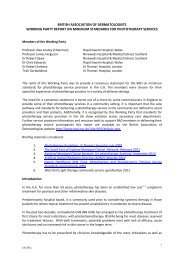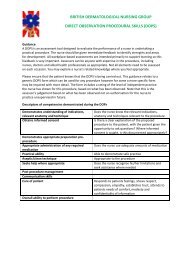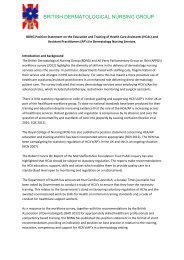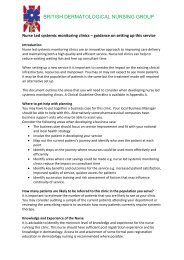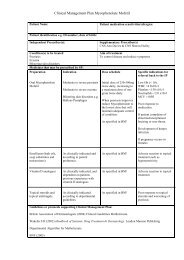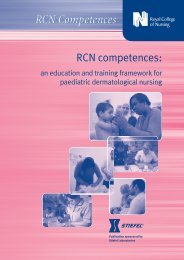Improving outcomes for people with skin tumours including melanoma
Improving outcomes for people with skin tumours including melanoma
Improving outcomes for people with skin tumours including melanoma
You also want an ePaper? Increase the reach of your titles
YUMPU automatically turns print PDFs into web optimized ePapers that Google loves.
<strong>Improving</strong> Outcomes <strong>for</strong><br />
People <strong>with</strong> Skin Tumours<br />
<strong>including</strong> Melanoma<br />
Organisation of <strong>skin</strong><br />
cancer services<br />
the opportunity cost <strong>for</strong> the consultant. In future, training will have to<br />
be undertaken to the accepted level of an accredited course, examples<br />
of which will be available and will involve accreditation by all relevant<br />
parties <strong>including</strong> BAD, RCGP, patient groups and primary care society<br />
in dermatology.<br />
It is not possible to estimate how many networks will commission<br />
GPwSI services. It is estimated that <strong>for</strong> a network <strong>with</strong> an average<br />
number of PCT/LHBs (8.78 per network), having a service involving<br />
three GPwSIs in each PCT/LHB, about 26 GPwSIs would be required,<br />
<strong>with</strong> some working part-time.<br />
F. Research priorities<br />
3<br />
All aspects of the impact of this proposed model of care should be<br />
evaluated using appropriate research methods.<br />
Teledermatology<br />
Teledermatology refers to the use of digital images, together <strong>with</strong><br />
relevant patient in<strong>for</strong>mation, as a means of aiding referral of patients<br />
<strong>with</strong> <strong>skin</strong> problems from primary to secondary care, and it can also be<br />
used as a means of communication between specialists in secondary<br />
care (store and <strong>for</strong>ward teledermatology). Real-time videoconferencing<br />
<strong>with</strong> patients from remote sites is also possible, and this guidance<br />
refers to this as a possible means of facilitating MDT work.<br />
The evidence <strong>for</strong> the benefits of store and <strong>for</strong>ward teledermatology as<br />
a means of triaging referral <strong>for</strong> patients <strong>with</strong> <strong>skin</strong> lesions is conflicting,<br />
as is the evidence regarding its cost-effectiveness. There are still many<br />
problems to be overcome be<strong>for</strong>e the use of teledermatology can be<br />
recommended as routine, not least the problem of ensuring patient<br />
confidentiality and the use of the Internet. It is most likely to be useful<br />
in aiding referral of patients from rural areas that may not have easy<br />
access to a specialist unit <strong>for</strong> rapid diagnosis.<br />
The guidance recommends more research into the most effective way<br />
of utilising teledermatology to triage patients <strong>with</strong> suspicious <strong>skin</strong><br />
lesions, looking at all aspects of its use <strong>including</strong> clinical accuracy,<br />
cost-effectiveness, patient confidentiality and patient acceptability.<br />
76<br />
National Institute <strong>for</strong> Health and Clinical Excellence




